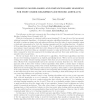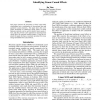352 search results - page 9 / 71 » The Structure of First-Order Causality |
EGOV
2010
Springer
13 years 8 months ago
2010
Springer
Within a framework for enriched on-line discussion forums for e-government policy-making, pro and con statements for positions are input, structurally related, then logically repre...
ICML
2005
IEEE
14 years 8 months ago
2005
IEEE
T ORDER REGRESSION (EXTENDED ABSTRACT) Kurt Driessensa Saso Dzeroskib a Department of Computer Science, University of Waikato, Hamilton, New Zealand (kurtd@waikato.ac.nz) b Departm...
STACS
2001
Springer
13 years 12 months ago
2001
Springer
In 1974 R. Fagin proved that properties of structures which are in NP are exactly the same as those expressible by existential second order sentences, that is sentences of the form...
CORR
2006
Springer
13 years 7 months ago
2006
Springer
We investigate here concept learning from incomplete examples. Our first purpose is to discuss to what extent logical learning settings have to be modified in order to cope with da...
AAAI
2004
13 years 9 months ago
2004
This paper concerns the assessment of linear cause-effect relationships from a combination of observational data and qualitative causal structures. The paper shows how techniques ...


